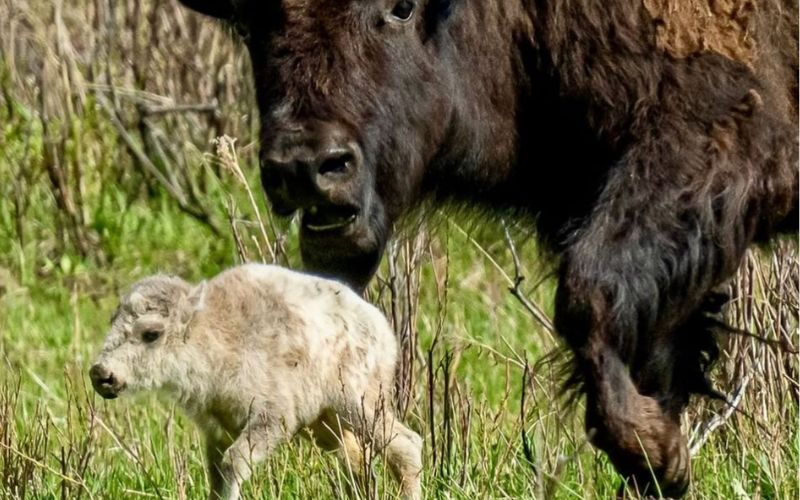
- Details
- By Kaili Berg
Last week at Yellowstone National Park, a sacred and rare event took place as a white buffalo calf was born. The occurrence holds deep significance for various Native American tribes, who revere the white buffalo as a powerful symbol of spirituality and hope.
Wildlife photographer Erin Braaten of Dancing Aspens Photo was there to capture the moment, although she just missed witnessing the birth, Braaten captured the photos of a lifetime.
In an interview with Cowboy State Daily, Braaten recounted her initial confusion and later realization of the extraordinary scene unfolding before her.
“We were just driving along, and there were some bison crossing the road,” Braaten told Cowboy State Daily. “I was looking back, and I saw what I thought maybe was a coyote.”
Upon closer inspection, she discovered it was a white bison calf. Remarkably, it had clearly just been born.
“The afterbirth, the placenta was still there, and the calf was just standing up,” Braaten said.
White bison are exceedingly rare and are often considered a sacred symbol among various Native American tribes. The white coloration may result from a genetic mutation known as leucism, which causes patches of white coloration on the skin or fur.
Unlike albinism, which is characterized by a complete lack of melanin, leucistic animals have reduced pigmentation, resulting in white or patchily colored fur while retaining normal eye color.
According to the National Bison Association, there are approximately 500,000 bison in North America, and only about one in every ten million bison born is white.
Among the Lakota people, the white bison holds a special place in their spirituality and traditions. The legend of the White Buffalo Calf Woman is central to their beliefs.
According to the legend, a white buffalo calf appeared to the Lakota many generations ago and transformed into a beautiful woman who taught them sacred ceremonies and imparted important spiritual knowledge. The White Buffalo Calf Woman promised to return again, signaling a time of peace and harmony.
Other tribes, such as the Cherokee, Sioux, and Mandan, also revere the white bison. For these tribes, the white bison symbolizes purity, spirituality, and the promise of prosperity. It is believed to be a powerful omen and a message from the Creator.
Yellowstone National Park plays a crucial role in the conservation of American bison. Once nearly driven to extinction, bison populations have rebounded due to concerted conservation efforts. The park's bison herd is one of the few remaining that has not been interbred with cattle, preserving their genetic purity.
More Stories Like This
Trump signs law that revokes some limits on drilling in Alaska’s National Petroleum ReserveSouthern Sierra Miwuk Nation Gets 900-Acres ofLand Back
Chilkat Indian Village Tells New Palmer Mine Owners They Are “Not Welcome” in Chilkat Valley
Tribes, Coastal Group Ask Army Corps to Revoke Permit for Texas Export Terminal
Michigan Tribes Tell Supreme Court: Don’t Bail Out Enbridge
Help us defend tribal sovereignty.
At Native News Online, our mission is rooted in telling the stories that strengthen sovereignty and uplift Indigenous voices — not just at year’s end, but every single day.
Because of your generosity last year, we were able to keep our reporters on the ground in tribal communities, at national gatherings and in the halls of Congress — covering the issues that matter most to Indian Country: sovereignty, culture, education, health and economic opportunity.
That support sustained us through a tough year in 2025. Now, as we look to the year ahead, we need your help right now to ensure warrior journalism remains strong — reporting that defends tribal sovereignty, amplifies Native truth, and holds power accountable.
 The stakes couldn't be higher. Your support keeps Native voices heard, Native stories told and Native sovereignty defended.
The stakes couldn't be higher. Your support keeps Native voices heard, Native stories told and Native sovereignty defended.
Stand with Warrior Journalism today.
Levi Rickert (Potawatomi), Editor & Publisher


